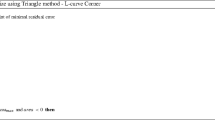Abstract
Since compressed video sequences may be corrupted or lost when transmitted over error-prone networks, error concealment techniques are very important for video communication. As a video sequence is a group of high-dimensional data, it can be considered as a big 3rd-order tensor. The methodologies that matricize high-dimensional data and then apply matrix-based method for further analysis often cause a loss of the internal structure information. Therefore, we built a tensor model to process such data, in order to preserve the natural multilinear structure. The key idea of our tensor model includes two parts. The first part is to construct a small tensor consist of the corrupted block and its several reference blocks. This part could be accomplished by block matching, but the traditional block matching might give a wrong match when the corrupted area is large and continuous. In order to overcome such situation, we proposed a flexible block matching scheme (FBM). The second part is to figure out the data in the corrupted part by tensor low rank approximation. Unlike the traditional low rank approximation, we did not fix the rank of core tensor as a constant number. Instead, the rank is flexible in our method, which is adaptive to the situation. Compared with some other error concealment method in the experiments, our method is able to achieve significantly higher PSNR (Peak Signal to Noise Ratio) as well as better visual quality.











Similar content being viewed by others
References
Braman K (2010) Tensor Decompositions and Application in Image Processing, Tensor Computation and Applications Minisymposium in SIAM Annual Meeting, July 13
Cai J, Candés EJ, Shen Z (2010) A Singular Value Thresholding Algorithm for Matrix Completion. SIAM J Optim 20(4):1956–1982
Candés EJ, Recht B (2009) Exact Matrix Completion via Convex Optimization. Found Comput Math 9(6):717–772
Chen Y, Hu Y, Au OC, Li H, Chen C (2008) Video error concealment using spatio-temporal boundary matching and partial differential equation. IEEE Trans Multimedia 10(1):2–15
Haskell P, Messerschmitt D Resynchronization of Motion Compensated Video Affected by ATM Cell Loss. In: Proc Int Conf Acoust, Speech, Signal Process. (ICASSP92), SanFrancisco, CA, USA, 1992, Vol. 3, pp 545–548
Kolda TG, Bader BW (2009) Tensor Decompositions and Applications. SIAM Rev 51(3):455–500
Lam WM, Reibman AR, Liu B (1993) Recovery of lost or erroneously received motion vectors. In: Proc IEEE Int Conf Acoustics, Speech, Signal Process., Vol. 3, pp. 417–420
Lathauwer LD (2000) On the best rank-1 and rank-(R 1, R 2, ... , R N ) approximation of higherorder tensors. SIAM J Matrix Anal Appl 21(4):1324–1342
Lee P, Kuo K, Chi C (2014) An Adaptive Error Concealment Method Based on Fuzzy Reasoning for Multi-View Video Coding. J Disp Technol 10(7):560–567
Lie W, Lee C, Yeh C, Gao Z (2014) Motion Vector Recovery for Video Error Concealment by Using Iterative Dynamic-programming Optimization. IEEE Trans Multimedia 16(1):216–227
Liu J, Musialski P, Wonka P, Ye J (2013) Tensor Completion for Estimating Missing Values in Visual Data. IEEE Trans Pattern Anal Mach Intell 35(1):208–220
Nguyen DT, Dao MD, Tran TD (2011) Error concealment via 3-mode tensor approximation. In: Proc IEEE Int Conf on Image Processing, pp. 2081–2084, Brussels
Persson D, Eriksson T, Hedelin P (2008) Packet Video Error Concealment with Gaussian Mixture Models. IEEE Trans Image Process 17(2):145–154
Schwarz H, Marpe D (2007) T Wiegand, Overview of the Scalable Video Coding Extension of the H.264/AVC Standard. IEEE Trans Circuits Syst Video Technol 17(9):1103–1124
Suh JW, Ho YS (2002) Error Concealment Techniques for Digital TV. IEEE Trans Broadcasting 48(4):299–306
Sullivan GJ, Ohm JR, Han WJ, Wiegand T (2012) Overview of the High Efficiency Video Coding (HEVC) Standard. IEEE Trans Circuits Syst Video Technol 22(12):1648–1667
Sun H, Challapali K, Zdepski J (1992) Error concealment in digital simulcast AD-HDTV decoder. IEEE Trans Consumer Electron 38(3):108–116
Tsekeridou S, Cheikh FA, Gabbouj M, Pitas I (1999) Motion Field Estimation by Vector Rational Interpolation for Error Concealment Purposes. In: Proc IEEE Int Conf Acoust, Speech, and Signal Processing, Vol. 6, pp. 3397–3400
Wang Z, Yu Y, Zhang D (1998) Best Neighborhood Matching: An Information Loss Restoration Technique for Block-based Image Coding Systems. IEEE Trans Image Process 7(7):1056– 1061
Yan B, NG KW (2003) A Novel Selective Motion Vector Matching Algorithm for Error Concealment in MPEG-4 Video Transmission over Error-prone Channels. IEEE Trans. Consum. Electron. 49(4):1416–1423
Yan B, H Gharavi A (2010) Hybrid Frame Concealment Algorithm for H.264/AVC. IEEE Trans Image Process 19(1):98–107
Zhang X (2013) Matrix Analysis and Applications, 2nd edn. Tsinghua University press, Beijing
Zheng J, Chau L (2003) A Motion Vector Recovery Algorithm for Digital Video using Lagrange Interpolation. IEEE Trans Broadcast 49(4):383–389
Zheng J, Chau L (2005) Efficient Motion Vector Recovery Algorithm for H.264 based on a Polynomial Model. IEEE Trans Multimedia 7(3):507–513
Zhou G, Cichocki A, Zhao Q, Xie S (2015) Efficient Nonnegative Tucker Decompositions: Algorithms and Uniqueness. IEEE Trans Image Process 24(12):4990–5003
Acknowledgments
The authors would like to thank all the anonymous reviewers for their valuable comments. This work is supported by National Natural Science Foundation of China (61372142, U1401252).
Author information
Authors and Affiliations
Corresponding author
Rights and permissions
About this article
Cite this article
Zhou, Z., Dai, M., Zhao, R. et al. Video error concealment scheme based on tensor model. Multimed Tools Appl 76, 16045–16061 (2017). https://doi.org/10.1007/s11042-016-3894-0
Received:
Revised:
Accepted:
Published:
Issue Date:
DOI: https://doi.org/10.1007/s11042-016-3894-0




